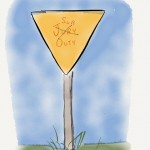In my classroom, the motto “Duty, Honor, Country” is displayed on my wall. Many of my students about two months into the school year ask me what gives with the motto? The biggest question I get is what kind of “duty” are you talking about Mr. Vargas? But when they do ask these questions, I take the time to stop teaching physics and teach them about the concept of “Civic Duty”. Good old-fashioned civics just like we all learned in middle school. Civic duties are the basic tenets of citizenship in this country.
The rules we follow, and the standards we set as a community, a people, and a country to live and stand behind. These tenets of how we conduct ourselves are equally as important as the content we share and are something I think we are taking for granted more and more. Along with basic civics, another thing I try to blend into my instruction is the value of knowing the past. For instance, why do we say the pledge of allegiance every day? Why is it we do the things we do that we sometimes take for granted every day.
As we go into Presidents Day weekend, I wanted to share with you how I passively teach through living monuments. So, what is a living monument? Unlike the traditional historic monolithic and permanent object that is most often associated with a specific episode of history. Living monuments focus on how history can be made alive, immediate, and relevant to people in their everyday surroundings. In other words, a small reminder in your daily grind of something that you wish to choose.
I learned about a student who died in Afghanistan in 2013. Our school’s only casualty of the war on terrorism. A monument was placed in his honor on our football field, and I felt like no one knew about it or even bothered to take notice. So, a few years ago I made a small placard and placed it under one of my chairs in my classroom. There’s a lock on the chair to denote this chair is special. Now when the kids put their chairs up, they often read the small monument/plaque and then put two and two together – that the kid on this chair is the same kid who is honored on the football field.
I now have several living monuments in my room, some obvious, and some not so obvious. A picture with a QR code attached to its corner can give students a chance to find out more if they are curious. Using a very simple app, students can download a link, which usually is a short YouTube video or article to read for the bus ride home. A chance to learn something more without directly taking away instructional time from my content.
Its very cool to watch this happen every year as the new kids make the connection. Kyle’s chair as we call it now, is reserved for the best students in my class. Its an honor to sit in his chair. It builds a connection, it teaches the value of honoring service above self in a passive informative way, and most importantly my kids no longer put gum under their desks or their seats. A simple way to honor and teach through living monuments.










Comments 2
Thank you fro sharing this. I appreciate this approach and I have also seen the personal connections students make to the lesson and the experience by using artifacts. I will include more historical pieces in my class.
I love this idea- living monuments!!! I can’t wait to try it next year in my classroom- thx for sharing.